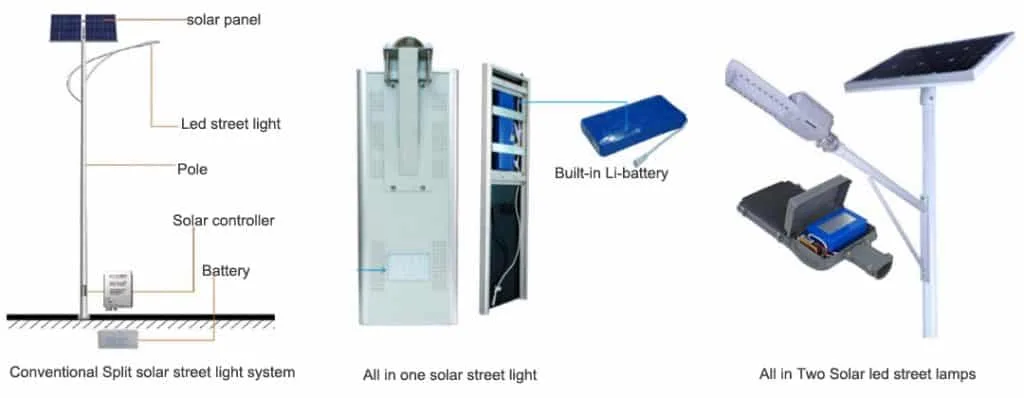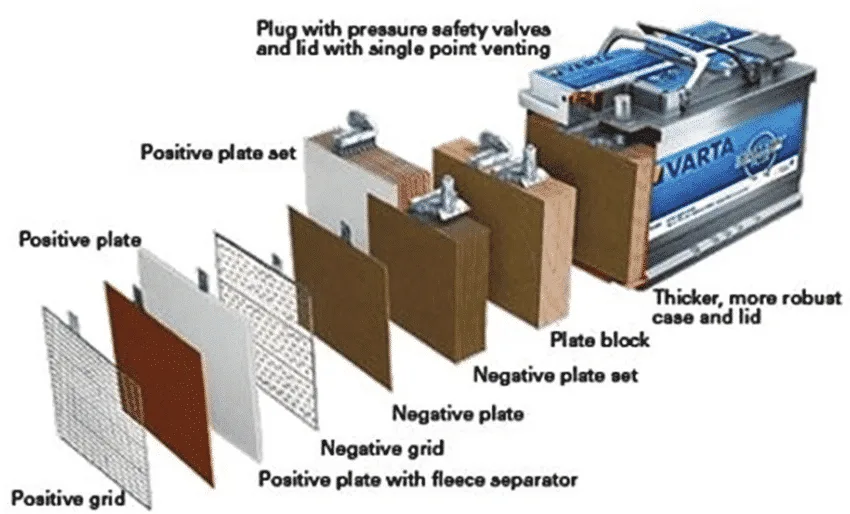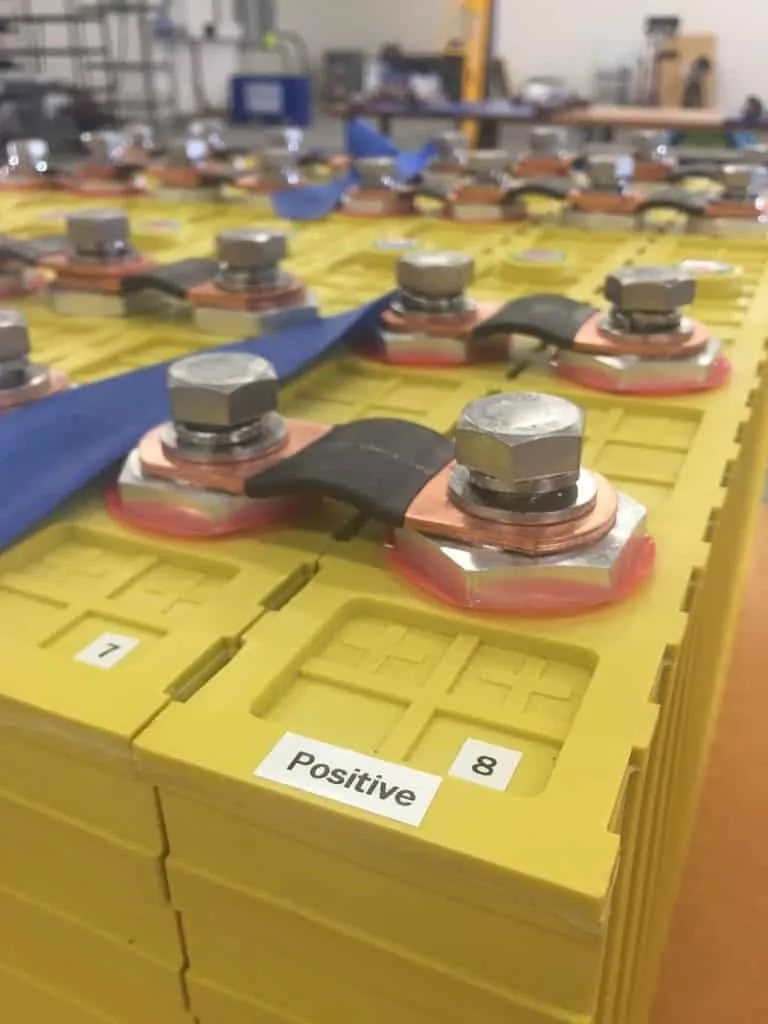It is very important for the batteries in the entire solar street light system. During the day, it stores the energy generated by solar panels and then discharges to supply energy to the solar street lamp when the light is insufficient or at night. Its quality and price directly determine the quality and price of the entire solar street light system. Therefore, the choice of battery is very important for different schemes or different types of solar street light systems.
How many types of solar-led street lights?
According to the different battery placement positions in the solar street light system, it can be roughly divided into three types of solar street lights.
- Coventional solar street lights
- Integrated solar street lights
- All in Two solar street lights
1. The traditional split solar street light system (led street light with separate solar panel and separate battery) is an independent distributed power supply system. The solar panels, batteries, light source, and other components in the system are all independent of each other. Generally, the storage battery is buried in the ground or placed on the street lamp pole.
2. The second type is integrated solar street lights, also called All-in-one solar street lights. It integrates all the parts and components required by the system into one lamp body, which is very convenient to install.
3. The third type is a derivative version of integrated street lights, called All in two solar street lights. This kind of street light mainly integrates the lithium battery and the solar control into the LED street lamp body, but a separate solar panel on the outside.

How many types of batteries for solar street lighting system?
Corresponding to the above different types of solar led street light systems, most led solar street lamp manufacturers use the following 4 types of batteries.
1. Lead-acid battery
Lead-acid battery (VRLA) is a kind of battery whose electrodes are mainly made of lead and its oxides, and the electrolyte is a sulfuric acid solution. It is also called AGM Battery.
images Source from: researchgate.net
Advantages: The voltage is relatively stable. Under the premise of the same capacity, its price is the cheapest among the four types of batteries;
Disadvantages: The specific energy is relatively low, so the volume is much larger than ordinary batteries. The service life of lead-acid batteries is relatively short, generally, 300-500 deep cycles. And maintenance is more frequent. But because of the price advantage, it is still widely used in the solar street light industry.
The nominal voltage of a single-cell lead-acid battery is 2.0V, which can be discharged to 1.5V and can be charged to 2.4V; in applications, 6 single-cell lead-acid batteries are often connected in series to form a lead-acid battery group with a nominal 12V or form 24V, 36V, 48V and so on. The common AGM battery 12V 24V series is 35AH~250AH. It is mainly suitable for traditional split solar street light systems.
2. GEL battery
GEL batteries belong to a development classification of lead-acid batteries. The method is to add a gelling agent to sulfuric acid to make the sulfuric acid electro-liquid into a colloidal state. It is equivalent to an upgraded version of lead-acid batteries. It is maintenance-free and solves the criticism of frequent maintenance of lead-acid batteries.
Advantages: The storage capacity, discharge capacity, and life are improved. The number of cycles is about twice as long as that of AGM batteries, which can reach 500-800 deep cycles. At the same time, the GEL battery can be used in the temperature range of -40℃-65℃, and its resistance to high and low temperatures is much better than that of AGM batteries. It can be used safely under various high and low-temperature conditions. Good seismic performance, suitable for long-distance transportation.
Disadvantages: The price is much higher than that of AGM batteries, sometimes even surpassing the price of lithium-ion batteries.
The colloidal electrolyte replaces the sulfuric acid electrolyte inside. The nominal voltage of a single-cell lead-acid battery is 2.0V, which can discharge When it reaches 1.5V, it can be charged to 2.4V; in the application of the solar street light system, multiple single-cell lead-acid batteries are often connected in series to form a nominal 12V or 24V 36V 48V lead-acid battery for use. Common GEL batteries for solar street lights include 12V 24V series 35AH~300AH. It is also mainly used for traditional split solar led street light systems.
3. Ternary lithium battery
Ternary polymer lithium battery refers to a lithium battery using lithium nickel cobalt manganate (Li (NiCoMn) O2) or lithium nickel cobalt aluminate as the positive electrode material. The nominal voltage of a single ternary lithium battery is 3.7V. In solar-led street lamp systems, 3.7V battery systems are usually used.
images Source from: pantip.com
Advantages: high specific energy, fast charging. Its deep cycle times are about 800-1000 times, life is similar to gel battery, working temperature is -30 to 55 Celsius, low-temperature resistance performance is very good, very suitable for use in low-temperature areas. Its size is very small, mainly used for Integrated solar street lights or All-in Two solar street lights.
Disadvantages: Poor high-temperature resistance. Its internal structure is not stable. If it is a ternary lithium-ion battery produced by an unqualified manufacturer, it may explode during the overcharging process, or in a higher temperature environment.
The price of this solution is the cheapest among lithium batteries, and of course, the capacity is also the lowest, but it is not suitable for solar street lamp systems with high power such as 100W and above. For some high-quality solar street lights, if ternary lithium batteries are used, professional manufacturers will use 11.1V systems (3pcs 3.7V battery do series), whose capacity is at least 3 times that of 3.7V, and of course, the price will be higher.
4. Lithium iron phosphate battery
Lithium iron phosphate battery is a kind of lithium-ion battery that uses lithium iron phosphate (LiFePO4) as the positive electrode material and carbon as the negative electrode material. The rated voltage of the single unit is 3.2V, and the charge cut-off voltage is 3.6V~3.65V. Solar-street lights with lithium iron phosphate batteries on the market are generally divided into 3.2V systems, 6.4V systems, and 12.8V systems. For small power and strict price requirements, 3.2V battery packs are generally used. The 12.8V battery packs are mainly used for high-quality street lights, it is long-lasting solar batteries.
images Source from Wiki
Advantages: low self-discharge rate, high energy density without memory effect, small size, fast charging, and long life. Its deep cycle charging times are generally 1500-2000 times. A set of lithium iron phosphate batteries is generally in normal use. It can be used for 8-10 years. High-temperature resistance can be used in an environment of -40℃-70℃, and the temperature range of use is relatively wide.
It has good stability and relatively stable electrochemical performance, which determines that it has a stable charging and discharging platform. Therefore, the structure of the battery will not change during the charging and discharging process, and it will not burn and explode. It is still very safe under special conditions such as extrusion and acupuncture.
Disadvantages: Under the premise of the same capacity, its price is the highest among the above 4 batteries.
Solar street light battery price
The cost of solar street light batteries will be seriously affected by different raw materials, such as the grade of the battery cells and the quality of the protective plate inside the lithium battery. When choosing different batteries, consumers need to pay attention to these points. The following is the average price for your reference.
| Battery types | AGM Batteries | GEL Batteries | Ternary Lithium battery | Ternary lithium battery | LiFePo4 Batteries | LiFePO4 batteries |
| Voltage/PACK | 12V | 12V | 3.7V | 11.1V | 3.2V | 12.8V |
| Average Price/AH(USD) | $0.7-$1/AH | $1.3-$1.6/AH | $0.4-$0.7/AH | $1.5-$2/AH | $0.5-$0.8/AH | $2.2-$2.8/AH |
Conclusion
Which battery solar street light to choose depends on the specific conditions of the customer or the project. Combining the different advantages and disadvantages of the above various batteries. The solar street light batteries buying guide as follows:
Integrated solar street lights, or All-in Two solar street lamps.
Conventional solar street light.

Hello, customers
My name is Ricky Wang, I’m the business manager of GRNLED. I have been in LED lights industry for more than 10 year. Feel free to contact us. I’m happy to provide you the best service and products.
Email: info@grnled.com | WeChat: ledfixture










